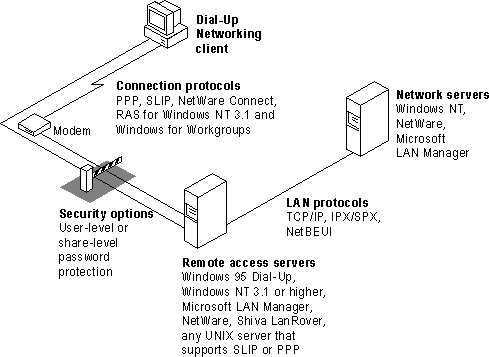
With Dial-Up Networking, you can connect from a remote site to a computer that has been configured as a remote access server, or connect to a network through the remote access server. For example, if you connect to a Windows 95 dial-up server, you can share its resources (if the Microsoft File and Printer Sharing service has been enabled), or you can use it as a gateway to a network that is running IPX/SPX and NetBEUI network protocols. As shown in the following figure a Windows 95 dial-up client can connect to a wide variety of networks because support is included for a variety of connection and network protocols.

Different remote access servers provide different security systems to protect access to a network. The Windows 95 dial-up server uses pass-through user-level or share-level security as described in "Using Security with Dial-Up Networking" later in this chapter.
You can use system policies and other methods to disable dial-in access so users cannot dial in to a particular desktop computer. For information, see "Disabling Dial-Up Server Support" later in this chapter. If the user chooses to dial in to a host system such as Windows NT, Shiva NetModem or LanRover, or NetWare Connect, Windows 95 offers full connectivity.
Dial-Up Networking uses the Windows 95 communications architecture to communicate through a modem to a network. It initializes the modem, determines device status, and dials the phone number by using TAPI and the Unimodem driver. For more information, see Chapter 24, "Introduction to Windows 95 Communications." For more information, "HowDial-Up Networking Works" later in this chapter.
A Windows 95 Dial-Up Networking configuration includes these components, as described in the following sections: